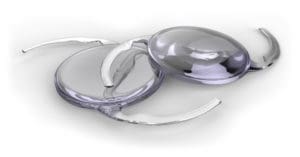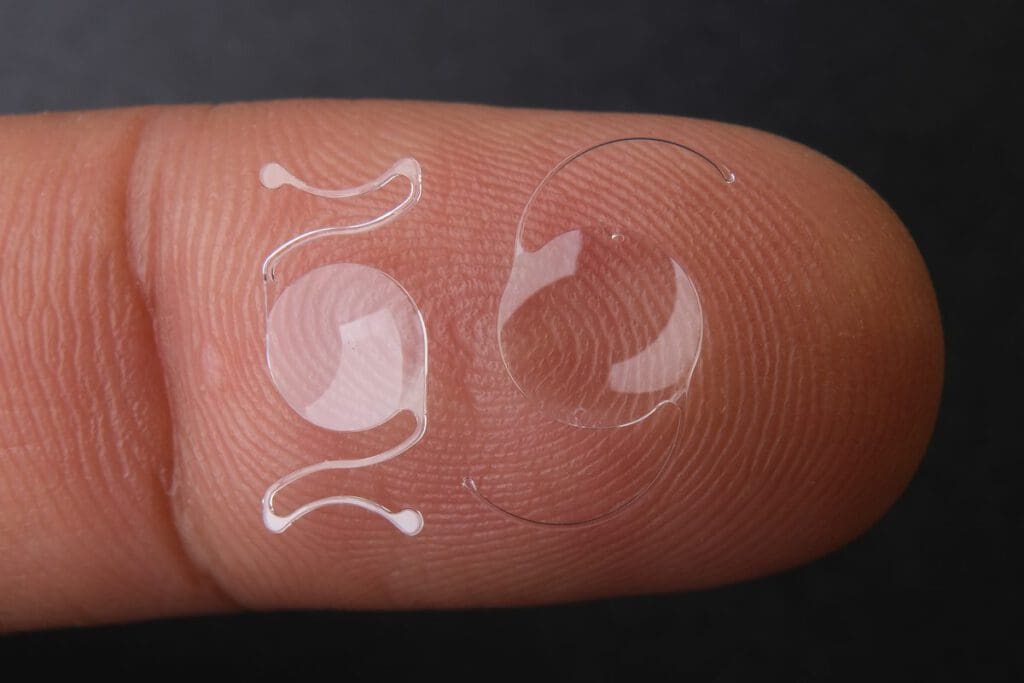
Medically Reviewed by Amarpreet Brar, M.D. NVISION Surgeon
Intraocular Lens (IOL) Implants: Lens Options
Home /
Last Updated:

Medically Reviewed by Amarpreet Brar, M.D. NVISION Surgeon

Article At a Glance
Intraocular lenses (IOLs) are artificial lenses that are implanted during eye surgery to replace the eye’s natural lens. IOLs are most commonly associated with cataract surgery, where they are used to restore vision after the removal of a clouded natural lens. But they can also be used to correct severe cases of myopia, farsightedness, astigmatism and presbyopia (age-related farsightedness) with refractive lens exchange (RLE) procedures.
Table of Contents
What are IOLs?
IOLs, or intraocular lenses, are small, clear artificial lenses that are implanted in the eye during cataract surgery or refractive lens exchange (RLE) procedures. IOLs significantly improve vision that has been affected by cataracts or severe refractive errors.
How do IOLs work?
IOLs use special technology to achieve sharp, clear, vibrant images. The lens of the eye, similar to a camera lens, allows light to pass through so our vision can focus. If the lens is not clear, vision is blurry. When the natural lens deteriorates, it has to be replaced with a new one. And like camera lenses, there are many models of IOLs.
You deserve clear vision. We can help.
With 135+ locations and over 2.5 million procedures performed, our board-certified eye surgeons deliver results you can trust.
Your journey to better vision starts here.
What are IOLs made of?
The main part of the IOL is called the optic. It is usually round or oval shaped and about 5-6 mm in diameter. The optic is responsible for focusing light. Attached to the optic are thin, plastic side arms called haptics. There are usually two haptics that hold the IOL in place inside the eye. The haptics are made to flex and allow the IOL to be folded for insertion through a small incision. They help anchor the IOL in place and prevent it from moving or dislocating.
Most IOLs today are foldable, allowing them to be inserted through an incision smaller than the diameter of the optic. This helps minimize surgical trauma and speeds up visual recovery.

IOLs also incorporate UV-blocking technology to protect your eyes from sun damage. This is achieved by dipping the IOL in special coatings, or incorporating UV-blocking components into the IOL. UV filters for IOLs have been around since the 1980s, and the technology has been extensively tested and improved since.
Your surgeon will make IOL recommendations based on your lifestyle, eye health, and vision goals. Once the IOL is in place, it becomes a permanent part of your eye, requiring no special care or maintenance, beyond the initial healing stage.
What procedures use IOL?
Intraocular Lens Implants for Cataracts
Cataracts are a common age-related condition that causes the eye’s natural lens to become cloudy, leading to blurred or distorted vision. As cataracts progress, they start to interfere with your daily life more and more. Updating your prescription is a temporary solution that becomes increasingly ineffective as the cataract worsens. Cataract surgery is eventually required to restore vision, providing corrected vision based on the characteristics of the specific intraocular lens used.
Cataract surgery is performed on an outpatient basis, with most patients returning home the same day. IOL implantation has a 99% success rate, is generally safe and can significantly improve vision and quality of life for cataract patients. IOLs are designed to provide life-long results, and the implant can remain in your eye forever, as it’s made of durable biocompatible materials.
However, like any surgery, cataract surgery does carry some potential risks and complications. It is important to discuss the potential risks and benefits with your eye doctor to determine if it is the right course of action for you.
IOL considerations for young children with cataracts

Cataracts in children are relatively rare, affecting about 3 out of every 10,000 children. However, they are a leading cause of treatable childhood blindness globally. The main treatment for cataracts in children is similar to an adult: Surgery to remove the cloudy lens and replace it with an artificial intraocular lens (IOL). However, IOL implantation is not always done right away. Instead, the child will wear contact lenses or glasses after cataract removal until they are old enough for IOL implantation. This allows the eye to grow and develop normally before inserting a permanent artificial lens.
The use of intraocular lenses in children is a specialized topic that requires careful consideration. Early intervention is often recommended to prevent permanent vision loss and promote normal visual pathways. Early intervention is often recommended to prevent permanent vision loss and promote normal visual pathways. Pediatric eye surgeons will work closely with the family to determine the most appropriate intraocular lens options and treatment approach based on the individual child’s needs and circumstances.
Intraocular Lens Implants for Refractive Lens Exchange
Intraocular lenses are also used in refractive lens exchange (RLE) procedures. RLE is a surgical option for individuals with severe refractive errors, such as high myopia (nearsightedness) or hyperopia (farsightedness), who are not suitable candidates for laser vision correction surgery. RLE can also treat presbyopia (age-related farsightedness) and astigmatism.
During RLE, the eye’s natural lens is removed and replaced with an IOL that corrects the refractive error, reducing or eliminating the need for glasses or contacts.
It is important to note that while IOL implantation can be an effective solution for various eye conditions, it is not suitable for everyone. Patients should consult with an experienced ophthalmologist to determine if they are good candidates for the procedure and to discuss the potential risks and benefits.
IOL Surgery Recovery
After your IOL procedure, your ophthalmologist will provide you with specific instructions for a smooth recovery.
Typical post-surgical care for all lenses includes:
- Use of medicated eye drops to prevent infection and reduce inflammation
- Avoid getting water, soap, or other irritants in the eye (Showers, cooking, sweat, etc).
- Avoid pressing or rubbing the eye. Patients that struggle with this are encouraged to wear a protective shield or eyeglasses for the first few days.
- Wear a protective shield over your eye during sleep.
- Avoid exercise, strenuous activities or heavy lifting until your doctor clears you for this type of activity.
- Do not drive until your vision has stabilized and your doctor deems it safe for you to resume.
Your doctor will also explain possible complications or risks associated with intraocular lens implants, such as:
- Movement of the IOL.
- Bleeding in the eye.
- Eye infection.
- Detached retina.
- Loss of vision.
- Pain that over-the-counter medication does not treat.
Types of IOLs
All IOLs provide clear vision, but the extent of your clear vision range will depend on the type of lens you choose.
IOLs come in various “focusing” powers. The most basic lenses provide one fixed focal point. More advanced lenses can achieve an extended range of clear vision. These lenses traditionally use technology that “splits” or “bends” light to create focal points at different ranges. Newer and more sophisticated models, such as light adjustable lenses, create an extended range of continuous vision instead of multiple focal points.
Some lenses were created specifically to address certain eye conditions, like astigmatism and presbyopia (age-related farsightedness), using special technology to address these issues on top of providing clear vision.
Intraocular lenses come in the following types:
Monofocal IOLs
Monofocal intraocular lenses are designed to provide clear vision at a single distance, either near, intermediate, or far. You will need glasses or contacts to see clearly at other distances. Most people who get monofocal lenses opt for distance vision, and use reading glasses for tasks requiring near vision.
Monofocal IOLs are a good choice for patients who:
- Are satisfied wearing glasses for reading and up-close work after surgery
- Have a lower budget for their IOL, as monofocals are the most affordable option
Monofocal IOLs may not be the best choice for patients who:
- Desire more independence from glasses
- Have a very active lifestyle that requires clear vision at multiple distances
Multifocal IOLs
These IOLs provide an extended range of clear vision. Traditional multifocal work by creating specific focal points set as specific distances, encompassing near, intermediate, and far distances. The latest multifocal models have upgraded technology that makes vision continuous across the intermediate to distant range instead of relying on focal points. However, near vision will be less clear than with traditional multifocals.
Multifocal IOLs are a great option for patients who:
- Have used multifocal glasses or would be candidates for these types of glasses
- Desire less dependence on glasses or contacts after their procedure
- Have an active lifestyle that requires clear vision at multiple distances
- Are willing to pay the additional cost, as multifocal IOLs are considered a premium lens option
While multifocal IOLs offer many benefits, they may not be the best choice for patients who:
- Have certain eye conditions like macular degeneration or diabetic retinopathy
- Are worried about temporary side effects like glare and halos around lights*
*These symptoms usually go away once the brain adapts to the new IOL after the first few months with the implant.
Accommodating IOLs
Accommodating IOLs have a flexible design that allows them to move or change shape when the eye’s muscles contract and relax. This process is called accommodation, and it’s what allows the eye to focus on objects at different distances. As people age, their eyes tend to lose flexibility and can’t change shape as easily to focus on nearby things. This condition is known as presbyopia. Accommodating IOLs mimic the natural accommodation process to restore a functional range of clear vision to presbyopic eyes).
Accommodating IOLs can be a good option for patients who:
- Want to reduce their dependence on reading glasses or bifocals after cataract or lens replacement surgery
- Have an active lifestyle that requires clear vision at multiple distances
- Have age-related farsightedness (presbyopia)
Accommodating IOLs may not be the best choice for patients who:
- Have very weak or limited ciliary muscle function, which is required for the lens to move
- Have certain eye conditions like macular degeneration or diabetic retinopathy that can limit visual outcomes
Light Adjustable Lenses
The light adjustable lenses are a unique type of intraocular lens (IOL) that allow for fine-tuning of the lens power after cataract or refractive lens exchange surgery. This is different from other IOLs which have a fixed prescription. The shape and focus of the lens changes in reaction to UV light treatments, allowing for precise customization of your vision. Because the lens shape can be molded, it can also correct astigmatism.
While LALs allow you to choose the exact focus of the lens, they do not offer an extended depth of vision. You will likely need glasses for certain activities. If you get LALs in both eyes, you can adjust each lens to different focal points to get a broader range of vision.
LALs are a great option for patients who:
- Have higher prescriptions or astigmatism that is difficult to correct with standard IOLs
- Have had refractive surgery (LASIK or PRK)
- Have corneal disease or prior corneal surgery
LALs may not be suitable for patients who:
- Have certain eye conditions like macular degeneration or diabetic retinopathy
- Are unable to commit to the multiple follow-up appointments for the UV light treatments
- Have a history of significant eye inflammation or sensitivity to UV light
LALs are more expensive than standard IOLs, so the additional cost may be a consideration for some patients.
Toric IOLs
Toric lenses are designed for people who have astigmatism, a condition that features uneven arc or curvature in their lens or cornea and causes blurry vision at all distances. A toric IOL has a special shape that compensates for this unevenness, effectively correcting the blurriness it causes. Toric lenses can be monofocal, multifocal or accommodating.
While toric IOLs can provide excellent distance vision, they may not be the best choice for patients who:
- Require very sharp near vision without glasses
- Have significant dry eye or blepharitis that is not well-controlled
- Have unstable corneas or irregular astigmatism
In these cases, a different IOL option may be preferable. Your surgeon will help determine if you are a good candidate for a toric IOL based on your individual eye health, visual needs, and lifestyle. You should also consider your budget, as toric lenses are not covered by insurance.
Phakic Intraocular Lenses
Phakic IOLs are a type of implantable lens that is placed in front of the natural lens, without removing the natural lens. Phakic IOLs are primarily used to correct high degrees of myopia (nearsightedness) in patients who have clear lenses and are not good candidates for laser vision correction.
Phakic IOLs are a good option for people with high refractive errors who are not candidates for LASIK or other corneal refractive surgeries:
- People with severe nearsightedness
- People with thin corneas that are not suitable for LASIK
- People with dry eyes or other corneal issues
- People who participate in contact sports and want a more stable vision correction
While phakic IOLs are generally safe and effective, they may not be the best choice for:
- People with certain eye conditions like glaucoma or cataracts
- People with shallow anterior chambers in the eye
- People with endothelial cell loss or corneal swelling
- People with unstable prescriptions
In these cases, an alternative vision correction procedure may be recommended. Your eye doctor will carefully evaluate your eyes and overall health to determine if you are a good candidate for phakic IOLs.
Keep in mind that if you undergo cataract surgery or RLE for both eyes, you may receive a different type of lens for each eye. Your surgeon will examine your eyes and see if they will need a different lens.
Before surgery, your doctor will ask you to list the medications you take, and they may advise against taking some of these prior to the procedure. Some people will have to use eye drops before their procedure.
You deserve clear vision. We can help.
With 135+ locations and over 2.5 million procedures performed, our board-certified eye surgeons deliver results you can trust.
Your journey to better vision starts here.
What IOLs are Right for Me?
To decide which type of IOL you will use, your eye surgeon will evaluate key factors, including general health, eye health, lifestyle preferences and vision goals. The main things to consider are:
- Vision Errors: The surgeon will assess your current refractive errors (myopia, farsightedness and astigmatism) and determine the ideal lens power to correct these issues. This helps them select an IOL that will optimize your vision.
- Lifestyle and Visual Demands: Your daily activities, hobbies, and visual needs play a big role. For example, if you spend a lot of time on a computer, the surgeon may recommend a multifocal IOL to provide clear vision at multiple distances.
- Eye Health and Anatomy: Your surgeon will examine your pupil size, shape and curvature of your cornea and the overall anatomy of your eye to determine which IOL will work best for your eye.
Finding the Right IOL
With intraocular lenses, your vision could be better than ever, forever. Whether you are looking to correct severe refractive errors or are in need of cataract surgery, our surgeons will examine your eyes and recommend options tailored to your vision goals and lifestyle. NVISION surgeons are experienced, professional and consistently rated among the best specialists in their field. Schedule a consultation today to get started.
The History of IOLs
Intraocular lenses were first developed in 1949 by British ophthalmologist Sir Harold Ridley in consultation with John Pike, an optical expert for the Rayner Optical Company. Cataract surgery already existed then, but there were no replacements for the lens that was removed.
They determined that perspex, a material used to build windows for the Royal Air Force during World War II, would be used. This is because airmen who were injured after this glass shattered did not experience inflammation, and that meant there was a possibility that this material would be compatible with the eye.
Materials for IOLs changed over the years, and updates to the surgery are continually made. Surgeries became more common in the 1970s, and they really took off in the 1980s. Today, cataract surgeries and placement of IOLs are safe, minimally invasive, and effective procedures.

You deserve clear vision. We can help.
With 135+ locations and over 2.5 million procedures performed, our board-certified eye surgeons deliver results you can trust.
Your journey to better vision starts here.
References
- Considering Cataract Surgery? What You Should Know. (September 2016). Harvard Health Publishing.
- Ocular Implants. (2019). The College of Optometrists.
- What Are the Different Types of Intraocular Implants and How Do I Decide on Which One to Get? (August 2009). ABC News.
- IOL Implants: Lens Replacements After Cataracts. (October 2019). American Academy of Ophthalmology.
- Cataract Surgery. (October 2019). American Academy of Ophthalmology.
- Multifocal Intraocular Lenses: Types, Outcomes, Complications, and How to Solve Them. (Oct–Dec 2017). Taiwan Journal of Ophthalmology.
- Cataract. MedlinePlus.
- Intraocular Lens Implant (IOL). (July 2017). American Association for Pediatric Ophthalmology and Strabismus.

Dr. Brar has been a board-certified ophthalmologist for more than 15 years, and has performed over 15,000 eye surgeries. He specializes in all-laser Custom LASIK, PRK, cataracts, intraocular lens implants and Wavefront technology.
This content is for informational purposes only. It may have been reviewed by a licensed physician, but is not intended to serve as a substitute for professional medical advice. Always consult your healthcare provider with any health concerns. For more, read our Privacy Policy and Editorial Policy.

